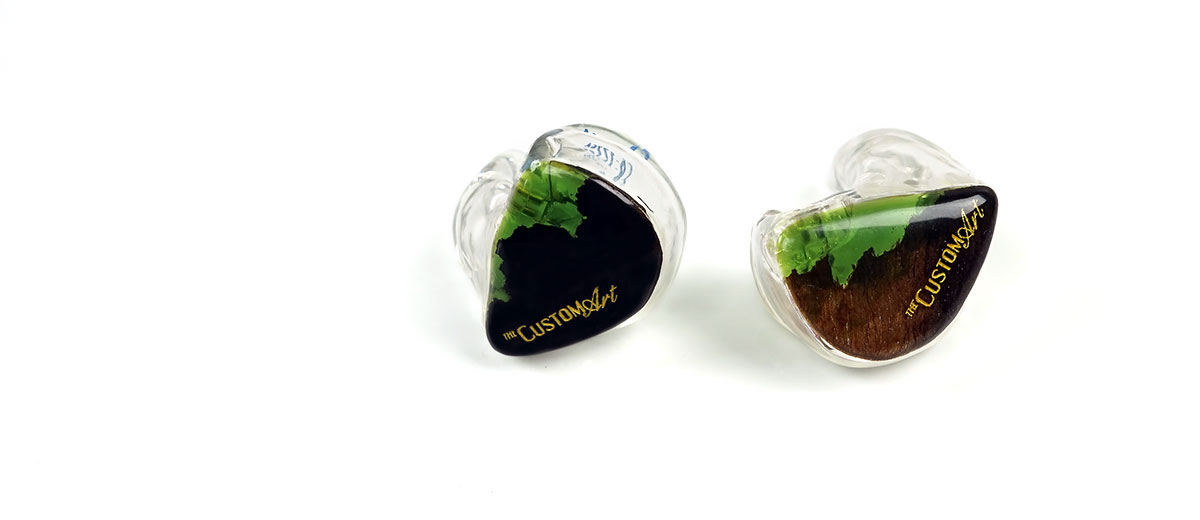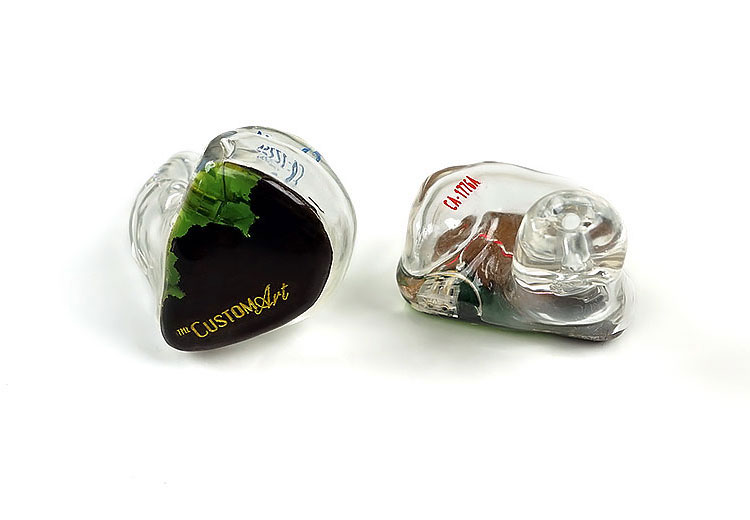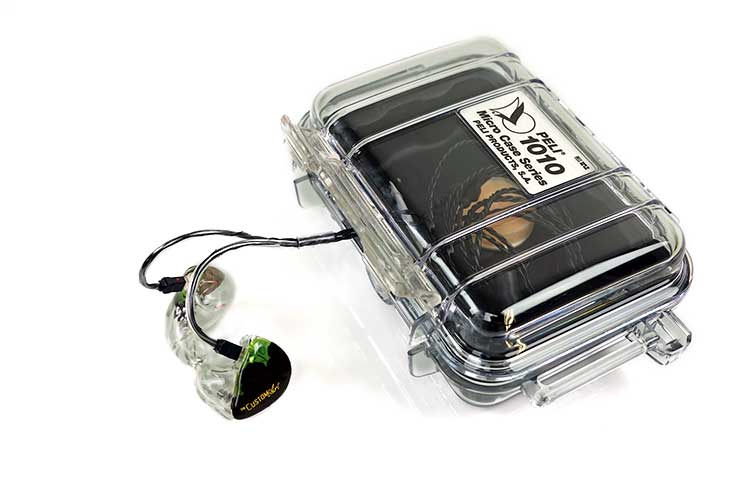Meet the FIBAE 1
Design
I actually did not give any specific direction to CA on the design for the FIBAE 1. Once again, Piotr was left to his own creative devices. he directed the team to scan our CIEM reviews and come up with a plan to deliver a unit with a green hue somewhere in the design. He believed that green was the one color not featuring much in our collection. How perceptive he is!
Shell
This is the first hollow body acrylic design I have received from Custom Art. Whilst I am still a big fan of silicone I have to say the acrylic finish is buttery smooth. Though this is custom made the unit is consistent with demo dealer units that use a transparent shell.
Faceplate
However, the faceplate is a bit of a mix and I am not entirely sure you can order it in the store. The best way I can describe it is an organic “fall” ambiance of autumn leaves with a mix of wood and a dash of green on the other side. From a distance, it looks like green and brown but closer up you see how unique it really. The left plate is not the same as the right leading me to believe these designs can never be duplicated exactly.
Finish
Sometimes less is more. In the case of the FIBAE 1, the lack of drivers (just one BA) combined with a superlative transparent finish makes every engineering tweak inside very easy to see. The fact I focus on this and not the shell tells you that the shell is perfect. Not a single undulating defect, bubble or crack to be seen anywhere.
Internals
Internals are pretty simple in placement and without any crossovers to deal with its also quite clutter-free. The BA used is a Knowles 33357 proprietary driver custom-tuned for the FIBAE IEM range. The armature driver sites pretty far back from the nozzle. In fact, it is placed just below the face-plate directly above the new advanced horn nozzle design.
New Horn Design
From the exit point of the armature, the design is tubed all the way down to the new horn designed tip which is a bit like an inverted cone. It has a wider exit, a bit like regular horn nozzles you see on VE and Rhines units but then it slims down to a narrow long tube that connects directly to the driver.
Wiring Color
One small note and something I quite like is the cable coloring in each shell. There is only one wire from the cable 2-pin 0.78mm flat socket extending to the armature driver. However, the color of that wire is red for the right shall and blue for the left shell. Mind you on a CIEM it is kind of hard to get them in the wrong ear given their precise dimensions but it is a nice touch.
Cables and Connectors
Connector Options
The FIBAE 1, much like the entire FIBAE range, does offer a range of connection choices. You can elect to go with a standard flat docket 0.78mm 2-pin cable or you can go MMCX. You can also elect to go with MMCX or 2-pin with a wireless remote/mic module.
Type
This is your typical Plastic One cable design to get you going out of the box. I don’t have any issues with this cable, particularly at this price point. It ticks all the boxes in terms of being light, pliant and just the right length for portable use (1.2m). I am presuming this is a 4 core copper wire cable and the sound signature suggests it is a bit but it is not overly warm as some other variants.
Upgrading the cable on the FIBAE 1 to something like the Effect Audio Thor II Silver will give you a nice boost in dynamics with a more holographic quality to the staging and a touch more top end sparkle. Something worth considering if you find the stock cable a bit too mild.
It is terminated with a right angle 3.5m gold-plated stereo jack on one end and finished with the usual 2-pin connectors on the other with left and right markings. The cable does have good memory hook materials. They are a little on the thick side but they retain their shape very well. Note this cable, as in all cables for the FIBAE 1 is designed to be worn over the ear.
Comfort & Seal
This is a comfortable fit with a pro length nozzle and a fairly secure position in the ear. Background noise is nil, isolation is full-on. Being a balanced armature driver design there are no vents so rest assured you will have the world blocked out with the FIBAE 1.
The accuracy of the acrylic shell from the mold is excellent. CA did a great job with zero gaps either open or closed jaw and no uneven pressure points. Credit to the audiologist I guess I can’t take away from the fact a great ear mold will help immensely.
Short Fitting Comparisons
64 Audio A18
I think 64 Audio have slightly greater detail on every bend and curve of your ear so it really fits like a glove. The FIBAE 1 has a little bit more pressure on the ear canals but not a huge amount. As a result, I think the A18 is perhaps the comfier of the two but the FIBAE 1 design isolates on another level. You have to remember 64 Audio use an APEX design for pressure relief. They are a tiny bit more porous with their more open M15 module and better isolating with the M20 module.
Unique Melody
Though UM uses a tri-bore design the tips are a touch more bulbous than the new horn design of the FIBAE 1. I generally found them to have about 10% less pressure towards the ear canal entry and a bit more pressure on the canal at the deepest point. The FIBAE 1 tended to be more even from top to bottom. That being said both have similar levels of excellent isolation.
Rhines
Rhines (Stage 7) I left on the shelf for about a year because the fit on the Stage 7 came back way too tight. Fast forward a year later and the fit is better now so we will churn out a review for these soon enough.
Rhines uses a traditional horn design with a wide single open bore. The fit has a bit more pressure on the sides of my canals than the top and bottom compared to the FIBAE 1 which is more uniform on pressure. Isolation is on par with the FIBAE 1 as it should be.
Sound Impressions
Tonality & Presentation
With a single BA, I generally look for a few things. The most important is a coherent and smooth sounding presentation because of the lack of crossover tuning required. The FIBAE 1 delivers that.
The second is usually a mid-centric bias with a little drop off on either side. The FIBAE 1 goes in that general direction but it is much more balanced than the charts would have you think which is a big plus.
The final pointer I tend to look for in a quality BA design is the general speed and resolution of the driver. Again, the Fibae 1 (F1) delivers a healthy level of BA speed and above-average resolution for this price point.
The F1 is a reasonably natural to neutral tonality with just a little mid-bass elevation and lower mids warmth solidity underpinning everything. Vocal presence is just slightly north of neutral but not hugely so. There is a little peak around 3-5k transitioning into an otherwise relaxed and easy-going treble.
Staging wise I find the FIBAE 1 to be quite well-rounded with a slight mid-range emphasis so you won’t find huge depth or extended highs but neither will you feel it is shelved down or brittle sounding. There is enough space and separation for everything to sound pleasingly clean and clear.
Overall the FIBAE 1 is an articulate but relatively forgiving signature that stays coherent throughout making it a very flexible IEM for most modern genres.
Bass
As is typical for most single BA designs the F1 doesn’t extend that deep so there is a bit of a drop-off slowly sub-100Hz. That is not to say the F1 lacks sub-bass presence, it just doesn’t generate typical sub-bass power you would find on larger BA drivers or dynamic drivers.
Instead, the focus is more on a gentle rise from 50 to 100Hz injecting a fuller-sounding and relatively snappy mid-bass response. One thing you can rely on with the F1 armature design is that fast-paced, tight, and articulate bass delivery I pointed out earlier. Nothing sluggish about the F1 low-end.
I must emphasize gentle rather than explosive or overly elevated. This is in no way a bloated mid-bass fuzzy experience. It is just enough warmth and body to ensure nothing sounds thin or anemic, especially its fundamentals which sound fairly accurate to me.
Mids
From 50Hz to 700hz (lower mids) there is a gentle but very correct drop in elevation for instrumental clarity and creating a bit of necessary space for the F1’s neutral instrumental positioning to sound clean and clear.
I think that is important because the mids on the F1 are fairly neutral both in terms of positioning and to a certain extent its general timbre. Decay and attack are finely balanced, I do not find the FIBAE 1 to be overly rich or annoyingly brittle in its note body.
Instead, it is quick, clean and clear, and pleasingly accurate. There is just a little added emphasis on vocal presence, though more for female than male vocals with a gentle nudge around 1-2k. Lately, I have found single BA designs to be exceptional for female vocals and the FIBAE 1 is no different in that respect.
Treble
Upper mids to lower treble transition is smooth sounding with just the right balance of body and articulation. There is a greater emphasis on its lower treble presence compared to its more rolled-off final octave.
From around 3-5k the FIBAE 1 gets a gentle but noticeable nudge north bringing in a bit more snap and perceptible articulation into percussion work. It is not overly peaked and doesn’t sound brittle or splashy sounding and it does a good job avoiding sibilance and unwanted nasty partial overtones creeping in.
From around 5-7k the FIBAE 1 falls away a bit though not in a way to make it sound shelved down or robbing the vocals of air. It has just enough headroom to breathe whilst still sounding relatively relaxed and smooth sounding.
Click on Page 3 below for Pairings & Comparisons




